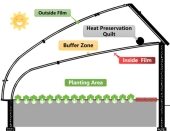Hi Bogdan,
Variability occurs for different instances, including for example seasonal businesses like you mentioned, or for variable rainfall inputs from roads, yards or full stream or river catchments etc. Each will need to be designed differently.
For seasonal variability in visitor numbers, your design should cater for the largest population size. Not necessarily for any single day (which may be a single spike in a year of otherwise low average numbers), but at least averaged out over a few days to a week (a longer average is ok if you have a larger wetland). There are different types of wetland design, most commonly: vertical flow gravel reed beds, horizontal flow gravel reed beds and soil based constructed wetlands. The vertical flow systems are not so good for dealing with seasonal flows because they run the risk of drying out when visitor numbers are low. (An exception this may be in Ireland and other places where the winters are good and wet to make up for the lower visitor numbers). For HF reed beds and constructed wetlands, the use of a plastic or heavy clay subsoil liner and outlet flow control weir (usually a pipe on an elblow, set at the right height) will ensure that when the population size is low, the water depth remains constant - it's just that the outlet flow volume will stop or slow down during the quiet season.
I know you're not asking this one, but I'll throw it in to answer the topic title rather than your question: For stormwater fed systems the designs are a little different. Here you'll need to have a restricted outlet to allow flood water to accumulate in the wetland and then drain down slowly afterwards. This means that the soil based wetlands are much more suitable than the gravel reed bed options. By virtue of their design, constructed wetlands survive occasional flooding better than gravel reed beds survive having plants left high and dry for much of the year, if that makes sense to you.
Scroll down through this article
http://www.engineersjournal.ie/2017/11/07/reed-beds-natural-solution-irelands-waste-treatment-problems/ to get a quick look at the basic differences between the layout of the different treatment wetland types.
Feel free to shout out some of your visitor numbers, location etc. and I'll have a look at the sizing needed.





 1
1








![Filename: Climate-data-nijne-selishe.jpg
Description: [Thumbnail for Climate-data-nijne-selishe.jpg]](/t/89329/a/62756/Climate-data-nijne-selishe.jpg)
 2
2








 2
2


















